This week’s theme for 52 Ancestors in 52 Weeks is “Shock.” When I read this theme, there was only one incident I could think of as a candidate. I hope my writing is sensitive enough for the task ahead.
By May 1929, my grandmother, Louise Fennelly Woodward had been married to her husband, Adrian Theodore Woodward, for nine years. They had two children, Nancy (7) and Adrian (2) and lived at that time in Arverne, New York. Louise was 31 and Adrian, a patent attorney, was 33. They had gotten married in 1919, just after Adrian’s honorable discharge from the 159th Aero Squadron in World War I as Sergeant First Class. And now, in what must have provoked lots of laughs, they rented a house at 6911 “Louise Avenue” in Arverne.
The Rockaway Peninsula in Queens, NY has prime beaches close to New York City.
Arverne is a suburban neighborhood of New York City, in the borough of Queens, but adjacent to the Atlantic Ocean on a long thin peninsula that creates an exceptionally beautiful beach and shoreline. The beach, generally known as “Rockaway Beach,” was and is still renowned for pristine sand and ocean access, and its close proximity to New York City. The adjacent hamlet to Arverne is called Rockaway Beach.
Louise was born in 1897, the second-born of five children, four girls and one boy, born to John Fennelly and his wife Catherine Prendergast in Worcester, Massachusetts. The one boy was named Anthony Fennelly and he was only 24 in 1929. These were the prohibition years, actually prohibition ran from 1920-33, so by 1929 prohibition was well underway. In contrast, the infamous stock market crash of October 1929 had not yet occurred in May 1929 so we may still call this time period the Roaring Twenties.
But Memorial Day at the end of May (previously called “Decoration Day”) signals the start of the beach season in many places and so it was around Rockaway Beach as well. With an older sister that lived in Arverne, next to the famous Rockaway Beach, 24-year-old Anthony came down from Massachusetts to visit his sister and her young family and take advantage of the beach opening. It was probably a visit that was looked forward to by both of them with happy hearts.
Rockaway Beach, with its pristine sand on the Atlantic Ocean, has always been a popular destination and always a scene of drownings with its dangerous rip currents.
Tragedy does have the very minor benefit for later generations of creating documentation of a death. On May 26, 1929, Anthony drowned while swimming in the Atlantic Ocean at Rockaway Beach. It seems other swimmers made attempts to save him but were unsuccessful, according to the newspaper article below from The Standard Union newspaper which ran in Brooklyn until 1932.
The Standard Union Newspaper article from May 27, 1929.
It is hard for me to imagine the shock my grandmother must have gone through, with her only brother drowning just blocks from her home while on a visit. He was 24, physically fit and a good swimmer according to family lore. However, “the Rockaways,” as the area beaches are called, are notorious for rip currents, which pull a swimmer out to sea. A quick internet search revealed numerous drownings at the Rockaways this year, nearly one hundred years later. By the 1930 census, Louise and her family had moved to a different house on Thursby Boulevard in Arverne, which perhaps helped her cope with this tragedy.











